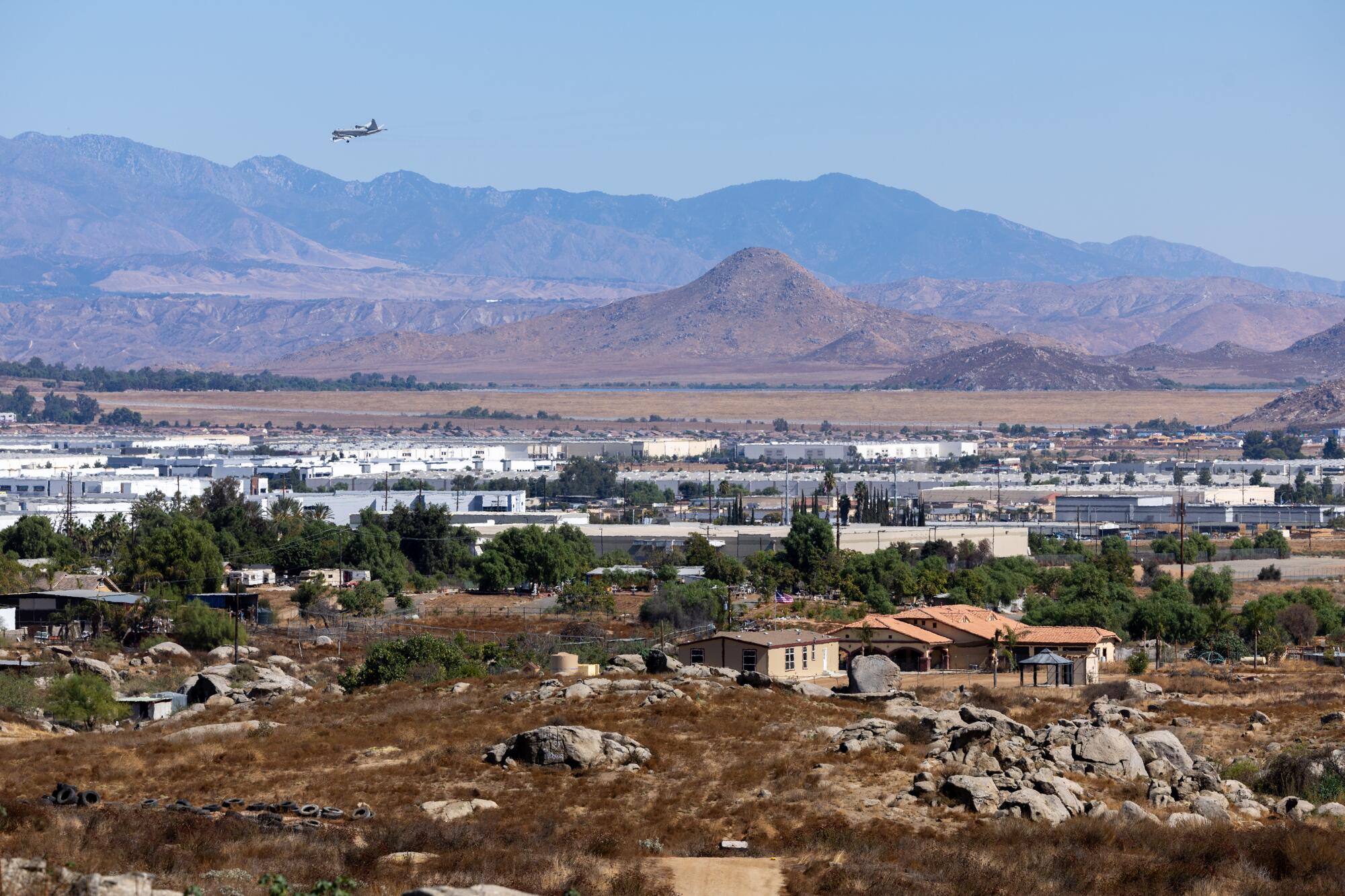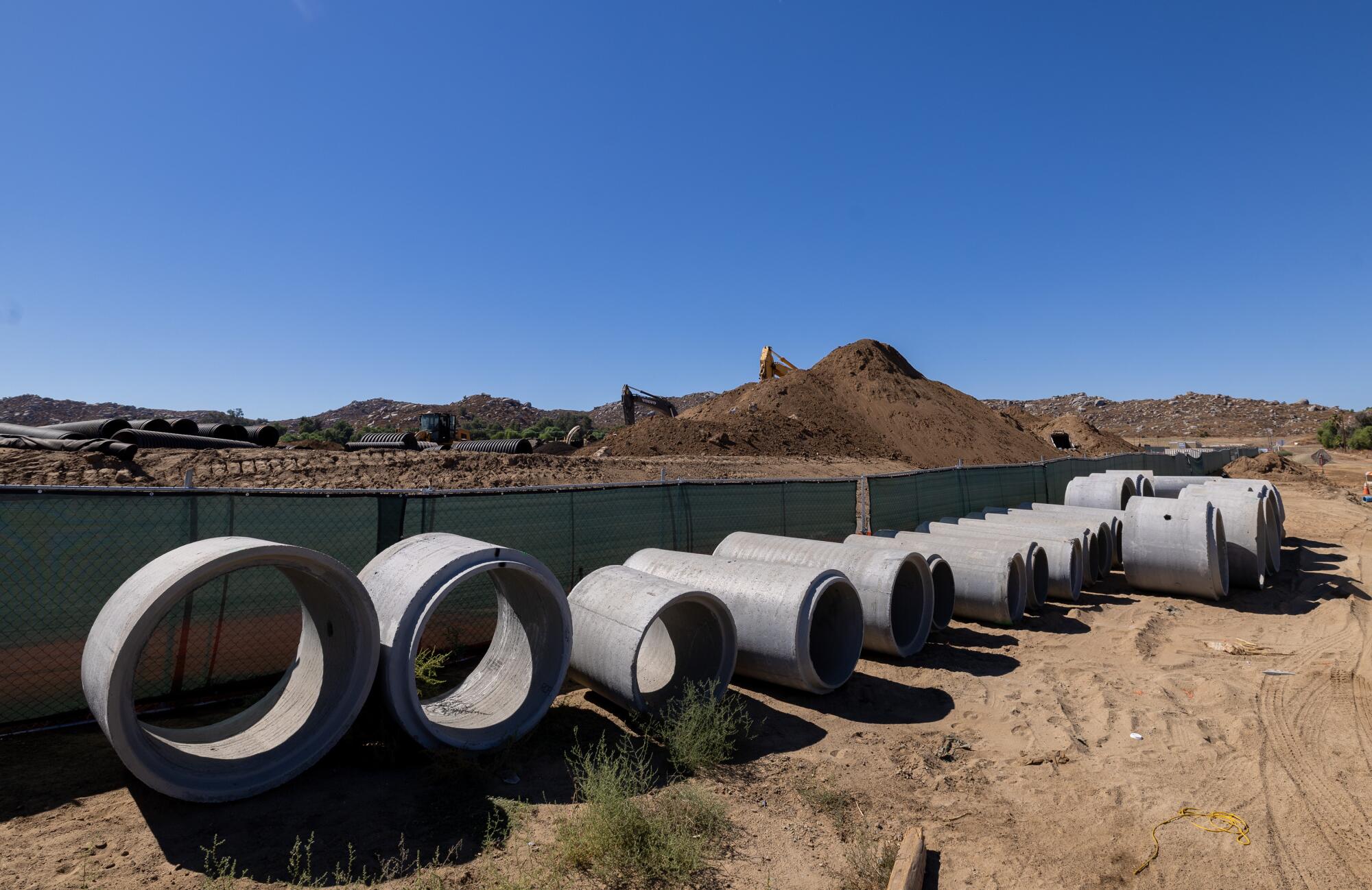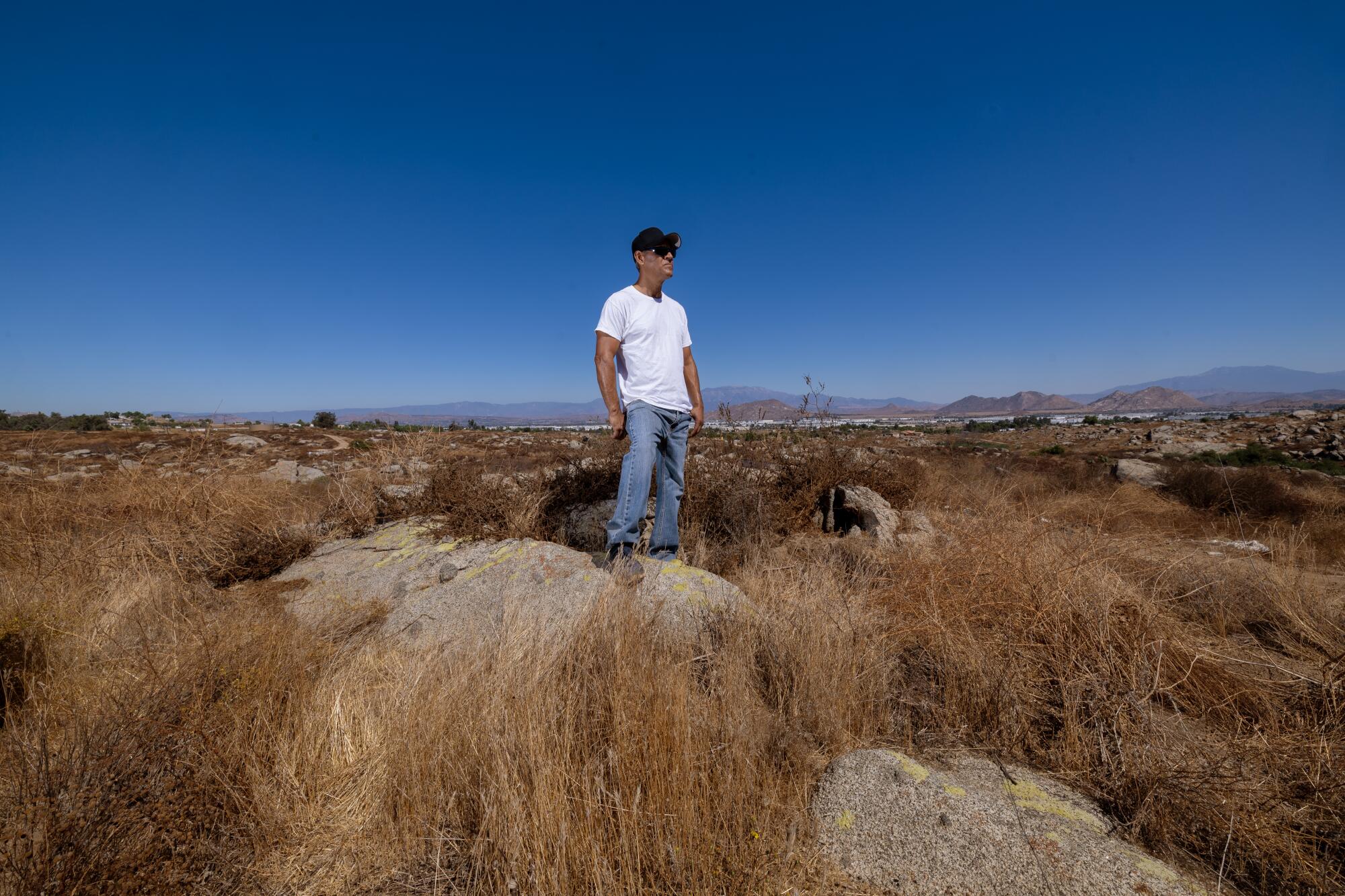Seen from above, the industrial-scale warehouses straddling Interstate 215 where it intersects Mead Valley shimmer like a sprawling lake of white concrete boxes.
In this unincorporated Riverside County community, the big-box distribution hubs responsible for fulfilling online shopping orders have long been contained to a substantial strip west of the freeway. Burlington, Living Spaces and FedEx are among nearly 50 warehouse properties located here, capitalizing on Mead Valley’s easy access to rail and freeway corridors.
Beyond this strip, though, Mead Valley residents embrace a rural lifestyle. People here raise horses and livestock; most streets are lined with gravel trails, rather than sidewalks, to accommodate riders on horseback. Besides the new Farmer Boys restaurant near the freeway, the community has few local businesses other than gas stations, feed stores and plant nurseries.
As e-commerce exploded during the COVID pandemic, more distribution centers rose along the freeway, bringing more trucks to local roadways. Still, there was an understanding that, beyond the clearly delineated industrial zone, Mead Valley residents could maintain their solitude and sweeping views, in exchange for shouldering a disproportionate share of an industry critical to America’s online shopping habit.
But that sacred line in the dirt — where warehouse development ends and rural living begins — could soon be blurred.
Riverside County leaders are reviewing a dozen requests that would rezone portions of rural residential land in Mead Valley to create more space for industrial warehouses.
(Brian van der Brug / Los Angeles Times)
County leaders are reviewing a dozen requests that would rezone portions of rural residential land in Mead Valley to create more space for industrial use. Developers are seeking to expand warehouse development beyond the established industrial zone; at least one proposal would result in the demolition of dozens of homes as well as dedicated open space. Others would pierce the existing boundary, bringing the potential for warehouses and their 24/7 noise and exhaust to the outskirts of existing neighborhoods, fundamentally altering residents’ lifestyles.
County Supervisor Kevin Jeffries, who represents the district that includes Mead Valley, said he has “deep concerns” about the proposed changes. He described drawing a “big red rectangle” over Mead Valley’s industrial zone, indicating where he believed the boundaries of warehouse development should remain.
“All the low-hanging easy parcels for warehousing are pretty much all spoken for. And so the really big, deep-pockets developers now see opportunities to try and propose to go beyond the boundaries that have been put in place for decades,” said Jeffries, who is retiring after 12 years on the board.
“It’s going to be a challenge if they cross that line and start marching into what you might call Mead Valley proper. You start moving up that way — when or where does it stop?”
Resident Karla Cervantes expressed similar concerns. Cervantes and her husband, Franco Pacheco, raise their children and sheep on two acres in Mead Valley. She worries neighborhoods will start falling like dominoes as more rural residential land is rezoned for industrial use.
“Once one neighborhood is surrounded by warehouses, then the investors will come, buy them out, and then it creeps up more and more and more,” Cervantes said.
The county’s general plan amendment process, a largely bureaucratic zoning review the county undertakes every eight years, could prove pivotal for residents of Mead Valley this year: Will leaders green-light the proposed zoning changes, paving the way for more warehouses — and with them more jobs and revenue flowing into county coffers? Or is this the moment that the rapid-fire proliferation of distribution centers stretching for miles in each direction along the 215 corridor finally slows?
Riverside County’s unique rezoning process is the result of a more than two-decade-old settlement with the conservation group Endangered Habitats League, which sued the county in 2003 over concerns about sprawling development.
The settlement “resulted in a way to slow-roll development in the rural areas of the county,” said county planning director John Hildebrand.
Under terms of the settlement, developers who want to request zoning changes for swaths of land from one of five major uses to another — agriculture, open space, rural, rural community or community development — are able to request that change only every eight years, during the county’s Foundation General Plan Amendment cycle.
The process was designed to provide county leaders with the opportunity to take a comprehensive look at rezoning proposals, and “look at the bigger picture instead of piecemealing it,” said Dan Silver, executive director of the Endangered Habitats League.
Mead Valley, a majority Latino community of about 20,500 people, already has 2,000 square feet of warehouses per person, including existing and approved warehouses and those under environmental review, according to a data analysis by Susan Phillips, director of the Robert Redford Conservancy for Southern California Sustainability at Pitzer College, and Mike McCarthy, an adjunct professor and data scientist at the college.
That’s one of the highest warehouse-per-resident ratios in the Inland Empire, according to their analysis. And the rezoning applications that developers have submitted would add more than 1,000 additional acres of warehouse projects.
In preparation for their requests, many developers have already positioned themselves as “property owners” of large parcels by getting enough local homeowners to agree to sell their land, in exchange for sizable payouts, contingent upon the county’s approval of the zoning changes.
The Planning Commission has so far heard three zoning-change requests for District 1, which includes Mead Valley; several were continued to future meetings. If supervisors approve the requests, the developers must return to get approval for specific projects.

“It’s going to be a challenge if they cross that line and start marching into what you might call Mead Valley proper,” Supervisor Kevin Jeffries says of warehouse development.
(Brian van der Brug / Los Angeles Times)
One developer, Hillwood, is seeking a zoning change to build a million-square-foot warehouse, along with a public park, on about 65 acres of land just west of Mead Valley’s industrial corridor.
Currently known as the Cajalco Commerce Center, the proposed development would require the demolition of 26 homes and a commercial building. The developer has promised an estimated 974 jobs, as well as infrastructure improvements and landscaping along a main thoroughfare, according to the project’s draft environmental impact report. It would have a “significant and unavoidable” impact on air quality and transportation, the report said.
Paz Treviño lives on the outskirts of Mead Valley’s industrial corridor, on a two-acre lot where he sells heavy construction equipment. He has agreed to sell his property to Hillwood for $3 million, contingent on county approvals, he said. He has outgrown his current lot, he said, and with the money he stands to make from selling his land, he hopes to buy five or 10 acres elsewhere.
A member of Mead Valley’s Municipal Advisory Committee, he supports allowing more industrial development.
The warehouses, he said, bring jobs to a community where fewer than 8% of residents have a bachelor’s degree. He’s heard concerns about the lack of grocery stores, restaurants and healthcare facilities, and predicted those amenities would come as family incomes rise.
“We’re going to start getting the stores that people want,” he said. “But we’re not going to get those other industries — the food industries, the retail industries — without first having a stabilized middle class.”
He is frustrated with the anti-warehouse advocates trying to stand in the way of rezoning, and believes landowners such as himself should be able to profit handsomely from their investments. “It’s the landowners that have the last say, is what I say,” he said. “And if you’re not within the area, mind your damn business.”

A warehouse development under construction in Mead Valley.
Shanowa De La Cruz could end up on the losing end of that equation.
De La Cruz, her wife and their children moved to a five-bedroom house on one acre in Mead Valley not far from Treviño’s property about three years ago. It was supposed to be their forever home, where they could raise their kids — five of six still live at home — as well as chickens, goats, ducks and a pig.
“We like our solitude. That’s why most of us live over here in Mead Valley,” De La Cruz said.
Six months after buying the property, they learned about the Cajalco Commerce Center proposal — and that some neighbors had already agreed to sell their properties to Hillwood. De La Cruz said she contacted the company and got an offer that barely covered what they paid for the home, presumably because the developer doesn’t need their property for the project.
The situation has left De La Cruz between a warehouse and a hard place: The developer would need to pay a “substantial” amount of money to get her family to move, she said. But if she stays and the proposal is approved, the development would loom nearby, infringing on their privacy and tanking their home value.
“It’s going to be one of those houses that is in between a warehouse” development, she said. “We’ve all seen those houses. No one’s going to buy that. You say, ‘Aw, pobrecito, they left them there.’”
Scott Morse, executive vice president with Hillwood, declined to comment on De La Cruz’s situation. He said the proposal has public support.
“We’re bringing something to the community that is needed and wanted by the community,” he said, “so that’s our compass.”

Mead Valley resident Raymond Torres says it’s “heartbreaking” to imagine the open space near his home converted for industrial development.
Raymond Torres moved away from the “hustle and bustle” of the San Diego area more than 20 years ago and eventually built two homes on a quiet street in Mead Valley.
Standing in his driveway on a clear day, he can see the San Jacinto and San Gabriel ranges, and Big Bear and Palomar mountains. Across the street from his property is open space, where he says he regularly sees owls and kangaroo rats among the grasses and native plants. His neighbors ride horses on the land; he prefers to traverse it on wheels — by dirt bike, quad or go-kart.
The property directly across the street from him is not proposed for rezoning, but a large swath of open land surrounding it is. The real estate and investment firm Deca has proposed rezoning 648.5 gross acres from rural residential to community development, with a mix of residential, commercial and industrial components, according to Travis Duncan, Deca’s vice president of development.
“Additionally, we intend to set aside a substantial portion of the property as open space and are excited about the mix of commerce and conservation that the project offers,” Duncan said.
Torres said it’s “heartbreaking” to imagine the land being used for development.
“It’s our neighborhood,” he said. “We have pride in it.”
The Deca proposal would also bring industrial development much closer to the home of Cervantes and Pacheco. Their two-lane street already has become a truck bypass. They are concerned warehouses will beget warehouses, eventually ending up in their backyard.
Mead Valley is oversaturated with warehouses and semis, they argue, and yet the community itself remains underinvested. Mead Valley would look “amazing” if it was actually benefiting from major portions of the revenue that industrial development is generating for Riverside County, Cervantes jokes. Pacheco notes that the closest Target — on the other side of the freeway — is not a retail store but a massive distribution center.
Earlier this year, Pacheco and Cervantes launched the Mead Valley Coalition for Clean Air to oppose warehouse expansion. They see the rezoning fight as a fight for Mead Valley’s future. For the residents who stay, the question is whether county leaders will rubber-stamp continued expansion of the I-215 industrial corridor, and whether that line in the dirt — between industrial and rural residential — will survive.
But Cervantes said trying to keep Mead Valley from drowning in the shimmering sea of white warehouses often feels like an uphill battle. She worries about a future with worse air quality and decreased property values, and about the limited opportunities for young people growing up amid a mass logistics hub.
“When they look to see the sun rise,” she said, “they’re going to see the sun rise on a bunch of warehouses.”
This article is part of The Times’ equity reporting initiative, funded by the James Irvine Foundation, exploring the challenges facing low-income workers and the efforts being made to address California’s economic divide.